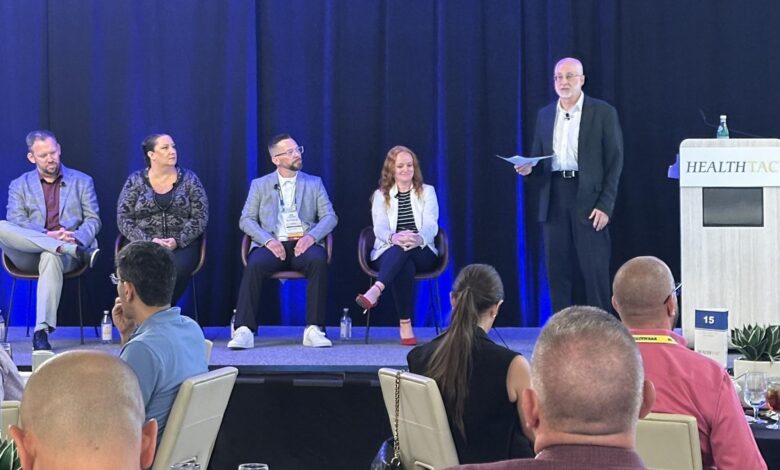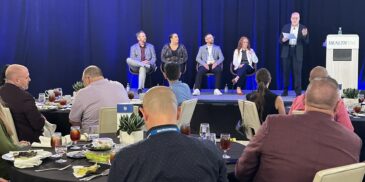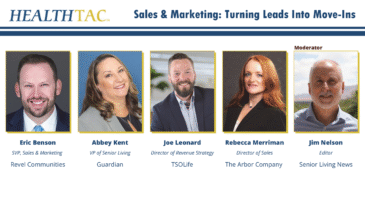
HEALTHTAC West 2025 Panel: Sales & Marketing: Turning Leads Into Move-Ins, Part 2
By Jim Nelson | October 10, 2025

NEWPORT BEACH, CA — At our annual HEALTHTAC West executive event, attendees had the opportunity to hear several panels; one of those panels, on sales and marketing, featured panelists Revel Communities’ Senior Vice President of Sales and Marketing Eric Benson; VP of Senior Living at Guardian, Abbey Kent; Joe Leonard, TSOLife’s director of revenue strategy; and Rebecca Merriman, a director of sales for The Arbor Company.
In part 1 of this article, the panelists got into some of the things that make it challenging to get to 100 percent occupancy; they also discussed both digital and traditional marketing methods, and we heard a great way to keep wait-listed future residents engaged.
As the moderator, I asked how AI is changing the ways in which the panelists market.
ABBEY KENT: It’s more about market shopping today, for a market survey, than ever before, and looking at the offerings and making sure that you’re competitive. Before it might [have been] that we have a swimming pool, now it’s, “What type of AI, how many different platforms of AI are you using, is it intuitive, and can the families look at it?” We have to look at it from the end-user perspective.
ERIC BENSON: One of the things that’s interesting is if we would do a big huddle about a specific building, we would pull all these different reports together and spend a day or two days or three days trying to figure out what’s the best way to go forward. Now we can do [it] in five hours by just dumping tons of data into an AI system. And some of the companies are being more sophisticated, they’re packaging that for you, so it’s not just your personal GTP that you’ve put together. I think you can leverage data analytics in a really sophisticated way; you have to know what you’re looking for. I would almost say it’s like fixing a car’s engine: AI will tell you whether the carburetor is broken, but if you don’t know how to fix a carburetor, nothing’s going to happen. It does point out where you should start looking; it really helps you leverage data. One of the things we’ve been talking about with some of the people here [at the HEALTHTAC event] is when you tie the sales data to the accounting data to the EHR data, you get this 360 view of what your business is, which helps you future-predict the business. You can better predict move-outs, move-ins, and where you should put your dollars.
 JOE LEONARD: This year we’ve definitely seen a proliferation of AI, and different permutations of it. Whether you’re using a chatbot or a mascot, or some sort of AI-assisted live salesperson to capture that discovery upfront, I think all of those are fantastic opportunities, but then how are you leveraging it after the fact? That is one thing that we originally did; we wanted to recognize as many of those patterns as possible, using that AI, to speak to, “We’ve had residents who were looking for a specific feature, and they found it here.” Now, as a sales and marketing team, I can speak directly to that, communicate the potential experience that this resident could have in this environment. What we’ve done since then is built out even further with additional sales tools. So, if you and your team are able to capture some really slick discovery and then feed it in, it’s going to automatically prepare all sorts of a welcoming experience for this resident. It’s going to create a customized digital signage message to welcome them into the community: “Hey, Joan, we’re so happy to see you.” Do we have some discovery on your interest? I can create a top 5 friend match based on specific areas of overlap, not an assumption just based on care levels. It’s, “You enjoy cruises, you like walking, you like gardening, I can facilitate you to connect with them on a lead tour,” and then be able to show you what you can anticipate in this environment.
JOE LEONARD: This year we’ve definitely seen a proliferation of AI, and different permutations of it. Whether you’re using a chatbot or a mascot, or some sort of AI-assisted live salesperson to capture that discovery upfront, I think all of those are fantastic opportunities, but then how are you leveraging it after the fact? That is one thing that we originally did; we wanted to recognize as many of those patterns as possible, using that AI, to speak to, “We’ve had residents who were looking for a specific feature, and they found it here.” Now, as a sales and marketing team, I can speak directly to that, communicate the potential experience that this resident could have in this environment. What we’ve done since then is built out even further with additional sales tools. So, if you and your team are able to capture some really slick discovery and then feed it in, it’s going to automatically prepare all sorts of a welcoming experience for this resident. It’s going to create a customized digital signage message to welcome them into the community: “Hey, Joan, we’re so happy to see you.” Do we have some discovery on your interest? I can create a top 5 friend match based on specific areas of overlap, not an assumption just based on care levels. It’s, “You enjoy cruises, you like walking, you like gardening, I can facilitate you to connect with them on a lead tour,” and then be able to show you what you can anticipate in this environment.
Experience tells us that chances are pretty likely that when a senior comes in to tour a community, he or she come to that decision by themselves; one of their children probably suggested it. So, I asked Merriman what methods she might use to figure out who that other person is and how to get in front of them.
REBECCA MERRIMAN: It’s most important to get that information during discovery, and beyond that, at the end of the tour, we highly encourage them doing a retour within two weeks, bringing their family members or decision makers with them, and having lunch. That’s one way that we do it. The other way is with external business development. We’re going to local communities that surround our community, doing talks there about senior living. We’re not setting up booths or really promoting The Arbor Company, or anything like that. We’re acting as experts in the field and having those conversations so we’re that resource when the time comes.
And where do they hold these talks?
RM: 55 and older communities will rent out their clubhouses, provide lunch or snacks, and we’ll do them in there.
EB: We put out surveys after the move-in process; I do three different surveys, and I find there’s actually better data in your third survey after the move-in, because some of the noise of the emotions go away. But before people move in — and this has changed so much over the last 10 years — 68.5 percent of our inquiries come in looking for themselves. We’ve always been marketing to the adult child, but now it’s actually the resident themselves coming in. So, you should completely change your marketing approach — maybe. What we found was in the post-move-in surveys, it was 84 percent and change said that somebody else influenced the decision to move in. And the biggest number of that, 75 percent, was the child, and then it was a split between a spouse and a friend. So, to your point, there’s an empty chair sometimes at the first tour and you have to figure out who that empty chair is. Who is the influencer that they didn’t bring with them, but there was a conversation before they got to the door. So, [we tell] our salespeople don’t take that tour at face value; somebody else is influencing them. You’ve got to find that influencer.
Next, I asked Leonard how TSOLife is able to help a sales and marketing teams leverage successful selling points.
JL: Eric, when we were talking yesterday, you shared that somebody had too much data; you have too much knowledge. There has to be a way for you to leverage a program and then start to analyze it and break down those patterns. One thing that our system will do is tell you exactly where residents are moving from. So, if you’re doing boots-on-the-ground marketing campaigns, redistribute those resources to somewhere where it’s going to be impactful. It’s just helping you refine in real time. It is fantastic what you can do in a short amount of time if you’re going to leverage it properly. That’s what we’re really trying to focus on.
Turning the Q&A over to the audience, Prosper Life Care CEO Scot Sandel asked about the goal of the company website; is it to provide the most amount of information available or simply to get the tour, he wondered.
EB: For me, it’s a conversion tool. What I really want is them to go [to the website], like it, and come in and tour the building. Because even if they don’t actually move in, the more people I get walking through my building, grassroots marketing, beyond that, the better.
AK: I agree. I think the most important thing on the website is to capture their information, to prompt them to give you their name and phone number, or just submit an email, or to chat with you. You should want them to have discovery with you and be intrigued by the little information they’ve received. It’s more about the look and feel of the site and making it easy to see than providing every data that they need.
RM: Our top priority is to get the tours, so we have internet sales managers — the first people that are going to get those leads and capture them; they book probably 70 percent of our tours for us, and they can do it in under two minutes. So, for us, it’s tours, get them into the building, talk to them, all that kind of good stuff; as soon as you can get them into the doors, then we can do our magic.
AK: I think as much as we look at the internet and AI and all of these technical things, I don’t think in senior living the human aspect is ever going to go away. It’s so important to connect the person with the person that’s actually going to be touring them, not just the person that’s feeding information. You buy from people you like and trust, and if you can walk through a day in a life with that future resident and understand their history saying, “Sally, walk me through your life. What did you do for a living before you retired?” They’re never going to get that connection through AI bots or anything else. Those are conversion tools to drive the lead however they prefer to be led, and however the company prefers leads to be funneled.





